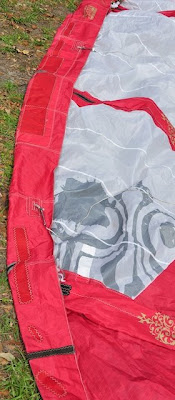
This nice looking wing is a Mac Para Eden 3 Paraglider. This one was sent to us by a long-time kite repair customer of ours, Brian Haupt. Thanks Brian. The cells had pesky damage on the lower skin that also effected the bridle attachment point. This first shot shows some of the damage and the disassembly that was necessary to properly repair this area. In my opinion, this wing is very nicely made. The blue tape in this shot is my way of keeping every stitch hole lined up on the dribs, the bridle point, and the rib they attach to while the skins are being healed up and repaired.

Below you can see the spread of the damage over several cells. It seemed that the wing smeared across a blunt object to cause these small and distributed lacerations.


I also noticed that there are two thread gauges used to make this wing. Of course they were easy to match, but it was interesting to see where the factory decided to use each gauge. Smaller gauge thread seems to lay a bit smoother in the final seam and it also makes your bobbins last longer between refills. Larger gauge thread doesn't always mean the stitch is stronger. If you sew onto an area that can keep up with the strength of the larger thread then it might be a good choice. But on thin cloth, large thread displaces the fibers of the cloth more drastically with larger holes and thus makes it weaker. This factory was smart, as you have to be when a life hangs from your wing.

I have done a lot of work with ram-air foils. I have
designed and built them, three sizes in total. I have also taken one of my favorite buggy kites [the quadrifoil competition C2] completely apart, stitch by stitch, to see what made it tick. Recently we've been repairing paragliders here. They are very complex wings internally. Not only do they have dribs, but they are also tediously built with small details all over that are not to be taken for granted. I always imagine the people sewing them from scratch. Like anything that is sewn, if you look closely you can see the human behind the machine. Paragliders are reasonably easy to work on, as long as you pay absolute attention to detail. These wings are a product of many many design decisions and there are no accidents in the way they are built.
.jpg)
.jpg)
















































